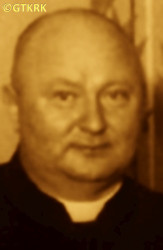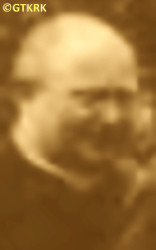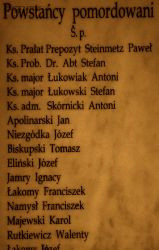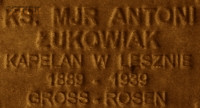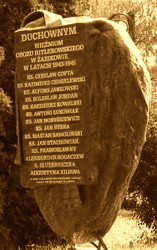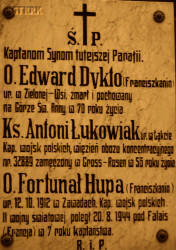Roman Catholic
St Sigismund parish
05-507 Słomczyn
85 Wiślana Str.
Konstancin deanery
Warsaw archdiocese, Poland
full list:
displayClick to display full list

searchClick to search full list by categories
wyświetlKliknij by wyświetlić pełną listę po polsku

szukajKliknij by przeszukać listę wg kategorii po polsku

Martyrology of the clergy — Poland
XX century (1914 – 1989)
personal data
surname
ŁUKOWIAK
forename(s)
Anthony (pl. Antoni)
function
diocesan priest
creed
Latin (Roman Catholic) Church RCmore on
en.wikipedia.org
[access: 2014.09.21]
diocese / province
Gniezno and Poznań archdiocese (aeque principaliter)more on
www.archpoznan.pl
[access: 2012.11.23]
RC Military Ordinariate of Polandmore on
en.wikipedia.org
[access: 2014.12.20]
date and place
of death
15.02.1945

KL Mittelbau‐Doraconcentration camp
today: n. Nordhausen, Nordhausen dist., Thuringia state, Germany
more on
en.wikipedia.org
[access: 2022.01.09]
alt. dates and places
of death
31.12.1946 (formal „court-stipulated” date)
details of death
During Polish–Russian war of 1919‐1921 prob. chaplain of the Polish Army.
After German and Russian invasion of Poland in 09.1939 and start of the World War II, did not receive mobilization orders.
After start of German occupation, attempting to avoid arrest went into hiding, among others from 1943 at his family Łąkta parish where however openly celebrated Holy Masses.
Finally arrested by the Germans on 10.06.1944.
On 29.06.1944 jailed in AL Posen‐Lenzingen penal camp.
Finally on 11.09.1944 transported to KL Groß‐Rosen concentration camp.
Prob. on 07.02.1945 evacuated from the camp — during the action of clearing out the German concentration camps in the east — in a so‐called „death march”.
The marches left KL Groß‐Rosen at the beginning of 02.1945 and c. 40,000 prisoners perished in them; KL Groß‐Rosen was captured by the Russians on 14.02.1945.
Marched to KL Mittelbau‐Dora concentration where arrived on 12.02.1945.
Few days later perished in the camp's „hospital” zone.
prisoner camp's numbers
58821Click to display source page (KL Groß‐RosenClick to display the description), 17046 (AL Posen‐LenzingenClick to display the description)
cause of death
extermination
perpetrators
Germans
sites and events
KL Mittelbau‐DoraClick to display the description, KL Groß‐RosenClick to display the description, AL Posen‐LenzingenClick to display the description, Reichsgau WarthelandClick to display the description, Ribbentrop‐MolotovClick to display the description, Pius XI's encyclicalsClick to display the description, Polish‐Russian war of 1919‐1921Click to display the description
date and place
of birth
19.05.1889Birth certification on:
photos.szukajwarchiwach.gov.pl
[access: 2025.04.13]

Sworowotoday: Pakosław gm., Rawicz pov., Greater Poland voiv., Poland
more on
en.wikipedia.org
[access: 2025.04.13]
parents
ŁUKOWIAK John
🞲 ?, ? — 🕆 ?, ?

STAŚKIEWICZ Antonina
🞲 ?, ? — 🕆 ?, ?
presbyter (holy orders)
ordination
19.12.1914

Gnieznotoday: Gniezno urban gm., Gniezno pov., Greater Poland voiv., Poland
more on
en.wikipedia.org
[access: 2021.12.18]
Assumption of the Blessed Virgin Mary RC archcathedral churchmore on
en.wikipedia.org
[access: 2025.03.14]
positions held
1937 – 1939
RC senior military chaplain — Lesznotoday: Leszno city pov., Greater Poland voiv., Poland
more on
en.wikipedia.org
[access: 2021.07.18] ⋄ garrison, Corps District OK No. VII Poznań, Polish Armed Forces ⋄ St Casimir RC military parish — also: administrator of a military parish (titular parish priest); chaplain of the 55th Poznań Infantry Regiment and the 17th Greater Poland Uhlan Regiment, stationed in the garrison
1921 – 1937
RC military chaplain — Lesznotoday: Leszno city pov., Greater Poland voiv., Poland
more on
en.wikipedia.org
[access: 2021.07.18] ⋄ garrison, Corps District OK No. VII Poznań, Polish Armed Forces ⋄ St Casimir RC military parish — commissioned; by decree of the Chief of State of ‐03.05.1922, confirmed with seniority from 01.06.1919 and 35th place on the list of Roman Catholic military chaplains, in the rank of captain; by decree No. L. 3448 of the Commander‐in‐Chief of 16.12.1921, verified with seniority from 01.04.1920 and 33rd place on the list of Roman Catholic military chaplains, in the rank of captain; also: administrator of a military parish (since 1925 titular parish priest); chaplain of the 55th Poznań Infantry Regiment and the 17th Greater Poland Uhlan Regiment, stationed in the garrison; chaplain of the Cadet Corps No. 3 in Rawicz (1925‐1926); chaplain of the garrison Military Hospital (1921‐1924)
1919 – 1921
RC military chaplain — Polish Armed Forces — by L. 2683 decree of the Commander‐in‐Chief of 12.03.1921, at the request of the Bishop's Curia of the Polish Army, demobilised from the Polish Army
1917 – 1918
vicar — Biezdrowotoday: Wronki gm., Szamotuły pov., Greater Poland voiv., Poland
more on
en.wikipedia.org
[access: 2021.06.20] ⋄ Exaltation of the Holy Cross and St Nicholas the Biship and Confessor RC parish ⋄ Lwówektoday: Lwówek gm., Nowy Tomyśl pov., Greater Poland voiv., Poland
more on
en.wikipedia.org
[access: 2020.11.27] RC deanery
1915 – 1916
vicar — Modrzetoday: Stęszew gm., Poznań pov., Greater Poland voiv., Poland
more on
en.wikipedia.org
[access: 2021.06.20] ⋄ St Giles the Abbot RC parish ⋄ Buktoday: Buk gm., Poznań pov., Greater Poland voiv., Poland
more on
en.wikipedia.org
[access: 2021.06.20] RC deanery
till 1914
student — Gnieznotoday: Gniezno urban gm., Gniezno pov., Greater Poland voiv., Poland
more on
en.wikipedia.org
[access: 2021.12.18] ⋄ philosophy and theology, Archbishop's Practical Theological Seminary (Lat. Seminarium Clericorum Practicum)
student — Poznańtoday: Poznań city pov., Greater Poland voiv., Poland
more on
en.wikipedia.org
[access: 2021.07.18] ⋄ philosophy and theology, Archbishop's Theological Seminary (Collegium Leoninum)
others related
in death
BŁĄDZIŃSKIClick to display biography Vladislav, BOGACZClick to display biography Adalbert, CAGClick to display biography Joseph, CAPClick to display biography Alexander, CHMIELNICKIClick to display biography Sigismund, DRYGASClick to display biography Francis, DRYGASClick to display biography John, GRYŹLAKClick to display biography Anthony, JĘDRAClick to display biography Martin, KOŚMIDERClick to display biography Adalbert, KRAJEWSKIClick to display biography Joseph, LEŃKOClick to display biography Joseph, PLUCIŃSKIClick to display biography Valentine, PYKOSZClick to display biography John, SAROSIEKClick to display biography Witold, STOPIŃSKIClick to display biography Joseph, SZMERGALSKIClick to display biography Simon, WĄDRZYKClick to display biography Anthony, WIĘCKIEWICZClick to display biography Leo, ŻUREKClick to display biography Anthony, GUZIKClick to display biography Stanislav, MAŁUSZYŃSKIClick to display biography Adam, MICHAŁKOWSKIClick to display biography John Chrysostom, PANKOWSKIClick to display biography Marian, WOJCIECHOWSKIClick to display biography Steven
sites and events
descriptions
KL Mittelbau‐Dora: German Germ. Konzentrationslager (Eng. concentration camp) KL, operational from 08.1943 till 11.04.1945 when American troops entered the camp. Set up to provide the slave workforce for an underground military factory „Mittelwerk” — in tunnels of Kohnstein mountain n. Nordhausen town V‐1 and V‐2 rockets were manufactured. Initially functioned as a sub‐camp of KL Buchenwald concentration camp (till summer 1944). Approx. 20,000 prisoner perished (large part of them were brought there at the end of 1944, in „death marches”, from KL Auschwitz), among whom 10,000 during camp evacuation (which also took form of „death marches”) — in 04.1945, right before liberation. Also c. 1,200 prisoners perished during bombardments by the Allied forces. (more on: en.wikipedia.orgClick to attempt to display webpage
[access: 2022.01.09])
KL Groß‐Rosen: Groß‐Rosen (today: Rogoźnica) was a German Germ. Konzentrationslager (Eng. concentration camp) KL, founded in the summer of 1940 (first transport of prisoners arrived on 02.08.1940). Initially a branch of KL Sachsenhausen concentration camp. In 1944 became a centre of a network of more than 100 camps. Prisoners were forced to slave at nearby granite quarries, on starvation rations. More than 125,000 prisoners were enslaved — 40,000 victims perished. In 1945 — in „death marches” — Germans dragged through the camp thousands of prisoners from the camp’s in east being one by one overrun by the Russians. The camp itself was captured by the Russians on 14.02.1945. (more on: www.gross-rosen.euClick to attempt to display webpage
[access: 2021.07.18], en.wikipedia.orgClick to attempt to display webpage
[access: 2019.02.02])
AL Posen‐Lenzingen: German detention‐penal Germ. Arbeitserziehungslager (Eng. corrective labour camp) in Luboń‐Żabikowo — c. 10 km from Poznań city center, in Greater Poland historical region, after start of German occupation in 1939 in German province Germ. Reichsgau Wartheland — functioning from 04.1943 till 1945, taking over the role of KL Posen concentration camp. Approx. 40,000 prisoners, mainly Polish intelligentsia, members of underground clandestine independence organizations and Russian POWs, were held captive. Most of them perished in the camp (some in mass executions). (more on: pl.wikipedia.orgClick to attempt to display webpage
[access: 2014.09.21], issuu.comClick to attempt to display webpage
[access: 2013.06.23])
Reichsgau Wartheland: After the Polish defeat in the 09.1939 campaign, which was the result of the Ribbentrop‐Molotov Pact and constituted the first stage of World War II, and the beginning of German occupation in part of Poland (in the other, eastern part of Poland, the Russian occupation began), the Germans divided the occupied Polish territory into five main regions (and a few smaller). The largest one was transformed into Germ. Generalgouvernement (Eng. General Governorate), intended exclusively for Poles and Jews and constituting part of the so‐called Germ. Großdeutschland (Eng. Greater Germany). Two were added to existing German provinces. From two other separate new provinces were created. Greater Poland region was one of them, incorporated into Germany on 08.10.1939, by decree of the German leader Adolf Hitler (formally came into force on 26.10.1939), and on 24.01.1940 transformed into the Germ. Reichsgau Wartheland province, in which the law of the German state was to apply. The main axis of the policy of the new province, the territory of which the Germans recognized as the Germ. „Ursprünglich Deutsche” (Eng. „natively German”), despite the fact that 90% of its inhabitants were Poles, was Germ. „Entpolonisierung” (Eng. „Depolonisation”), i.e. forced Germanization. C. 100,000 Poles were murdered as part of the Germ. „Intelligenzaktion”, i.e. extermination of Polish intelligentsia and ruling classes. C. 630,000 were forcibly resettled to the Germ. Generalgouvernement, and their place taken by the Germans brought from other areas occupied by Germany (e.g. the Baltic countries, Bessarabia, Bukovina, etc.). Poles were forced to sign the German nationality list, the Germ. Deutsche Volksliste DVL. As part of the policy of „Ohne Gott, ohne Religion, ohne Priesters und Sakramenten” (Eng. „No God, no religion, no priest or sacrament”) most Catholic priests were arrested and sent to concentration camps. All schools teaching in Polish, Polish libraries, theaters and museums were closed. Polish landed estates confiscated. To further reduce the number of the Polish population, Poles were sent to forced labor deep inside Germany, and the legal age of marriage for Poles was increased (25 for women, 28 for men). The German state office, Germ. Rasse‐ und Siedlungshauptamt (Eng. Main Office of Race and Settlement) RuSHA, under the majesty of German law, abducted several thousand children who met specific racial criteria from Polish families and subjected them to forced Germanization, handing them over to German families. After the end of hostilities of World War II, the overseer of this province, the Germ. Reichsstatthalter (Eng. Reich Governor) and the Germ. Gauleiter (Eng. district head) of the German National Socialist Party, Arthur Karl Greiser, was executed. (more on: en.wikipedia.orgClick to attempt to display webpage
[access: 2024.06.21])
Ribbentrop‐Molotov: Genocidal Russian‐German alliance pact between Russian leader Joseph Stalin and German leader Adolf Hitler signed on 23.08.1939 in Moscow by respective foreign ministers, Mr. Vyacheslav Molotov for Russia and Joachim von Ribbentrop for Germany. The pact sanctioned and was the direct cause of joint Russian and German invasion of Poland and the outbreak of the World War II in 09.1939. In a political sense, the pact was an attempt to restore the status quo ante before 1914, with one exception, namely the „commercial” exchange of the so‐called „Kingdom of Poland”, which in 1914 was part of the Russian Empire, fore Eastern Galicia (today's western Ukraine), in 1914 belonging to the Austro‐Hungarian Empire. Galicia, including Lviv, was to be taken over by the Russians, the „Kingdom of Poland” — under the name of the General Governorate — Germany. The resultant „war was one of the greatest calamities and dramas of humanity in history, for two atheistic and anti‐Christian ideologies — national and international socialism — rejected God and His fifth Decalogue commandment: Thou shall not kill!” (Abp Stanislav Gądecki, 01.09.2019). The decisions taken — backed up by the betrayal of the formal allies of Poland, France and Germany, which on 12.09.1939, at a joint conference in Abbeville, decided not to provide aid to attacked Poland and not to take military action against Germany (a clear breach of treaty obligations with Poland) — were on 28.09.1939 slightly altered and made more precise when a treaty on „German‐Russian boundaries and friendship” was agreed by the same murderous signatories. One of its findings was establishment of spheres of influence in Central and Eastern Europe and in consequence IV partition of Poland. In one of its secret annexes agreed, that: „the Signatories will not tolerate on its respective territories any Polish propaganda that affects the territory of the other Side. On their respective territories they will suppress all such propaganda and inform each other of the measures taken to accomplish it”. The agreements resulted in a series of meeting between two genocidal organization representing both sides — German Gestapo and Russian NKVD when coordination of efforts to exterminate Polish intelligentsia and Polish leading classes (in Germany called «Intelligenzaktion», in Russia took the form of Katyń massacres) where discussed. Resulted in deaths of hundreds of thousands of Polish intelligentsia, including thousands of priests presented here, and tens of millions of ordinary people,. The results of this Russian‐German pact lasted till 1989 and are still in evidence even today. (more on: en.wikipedia.orgClick to attempt to display webpage
[access: 2015.09.30])
Pius XI's encyclicals: Facing the creation of two totalitarian systems in Europe, which seemed to compete with each other, though there were more similarities than contradictions between them, Pope Pius XI issued in 03.1937 (within 5 days) two encyclicals. In the „Mit brennender Sorge” (Eng. „With Burning Concern”) published on 14.03.1938, condemned the national socialism prevailing in Germany. The Pope wrote: „Whoever, following the old Germanic‐pre‐Christian beliefs, puts various impersonal fate in the place of a personal God, denies the wisdom of God and Providence […], whoever exalts earthly values: race or nation, or state, or state system, representatives of state power or other fundamental values of human society, […] and makes them the highest standard of all values, including religious ones, and idolizes them, this one […] is far from true faith in God and from a worldview corresponding to such faith”. On 19.03.1937, published „Divini Redemptoris” (Eng. „Divine Redeemer”), in which criticized Russian communism, dialectical materialism and the class struggle theory. The Pope wrote: „Communism deprives man of freedom, and therefore the spiritual basis of all life norms. It deprives the human person of all his dignity and any moral support with which he could resist the onslaught of blind passions […] This is the new gospel that Bolshevik and godless communism preaches as a message of salvation and redemption of humanity”… Pius XI demanded that the established human law be subjected to the natural law of God , recommended the implementation of the ideal of a Christian state and society, and called on Catholics to resist. Two years later, National Socialist Germany and Communist Russia came together and started World War II. (more on: www.vatican.vaClick to attempt to display webpage
[access: 2023.05.28], www.vatican.vaClick to attempt to display webpage
[access: 2023.05.28])
Polish‐Russian war of 1919‐1921: War for independence of Poland and its borders. Poland regained independence in 1918 but had to fight for its borders with former imperial powers, in particular Russia. Russia planned to incite Bolshevik‐like revolutions in the Western Europe and thus invaded Poland. Russian invaders were defeated in 08.1920 in a battle called Warsaw battle („Vistula river miracle”, one of the 10 most important battles in history, according to some historians). Thanks to this victory Poland recaptured part of the lands lost during partitions of Poland in XVIII century, and Europe was saved from the genocidal Communism. (more on: en.wikipedia.orgClick to attempt to display webpage
[access: 2014.12.20])
sources
personal:
www.wtg-gniazdo.orgClick to attempt to display webpage
[access: 2012.11.23], issuu.comClick to attempt to display webpage
[access: 2013.06.23], parafiazielonawies.bloog.plClick to attempt to display webpage
[access: 2016.08.14], photos.szukajwarchiwach.gov.plClick to attempt to display webpage
[access: 2025.04.13], www.ordynariat.wp.mil.plClick to attempt to display webpage
[access: 2012.11.23], biographies.library.nd.eduClick to attempt to display webpage
[access: 2014.05.09], www.straty.plClick to attempt to display webpage
[access: 2015.04.18]
original images:
issuu.comClick to attempt to display webpage
[access: 2016.05.30], lbc.leszno.plClick to attempt to display webpage
[access: 2024.12.13], issuu.comClick to attempt to display webpage
[access: 2016.05.30], www.wtg-gniazdo.orgClick to attempt to display webpage
[access: 2014.01.06], zabikowo.home.plClick to attempt to display webpage
[access: 2014.01.06], www.polskaniezwykla.plClick to attempt to display webpage
[access: 2014.01.06]
LETTER to CUSTODIAN/ADMINISTRATOR
If you have an Email client on your communicator/computer — such as Mozilla Thunderbird, Windows Mail or Microsoft Outlook, described at WikipediaPatrz:
en.wikipedia.org, among others — try the link below, please:
LETTER to CUSTODIAN/ADMINISTRATORClick and try to call your own Email client
If however you do not run such a client or the above link is not active please send an email to the Custodian/Administrator using your account — in your customary email/correspondence engine — at the following address:

giving the following as the subject:
MARTYROLOGY: ŁUKOWIAK Anthony
To return to the biography press below:
 Click to return to biography
Click to return to biography








